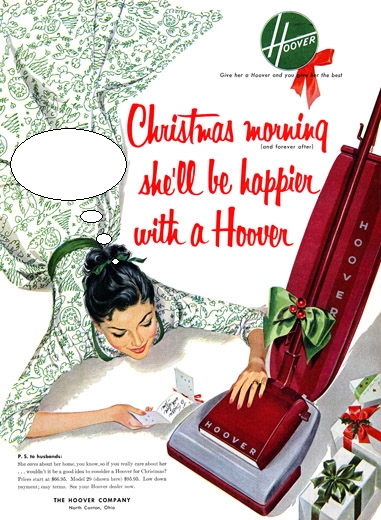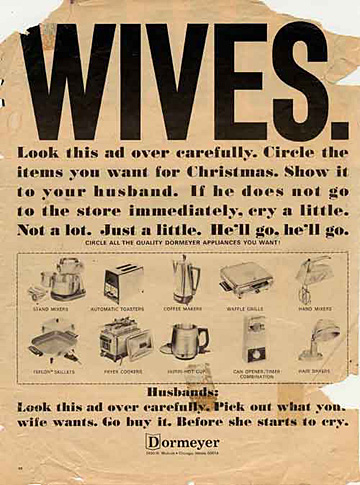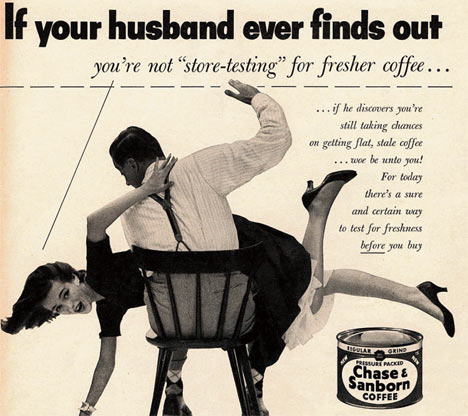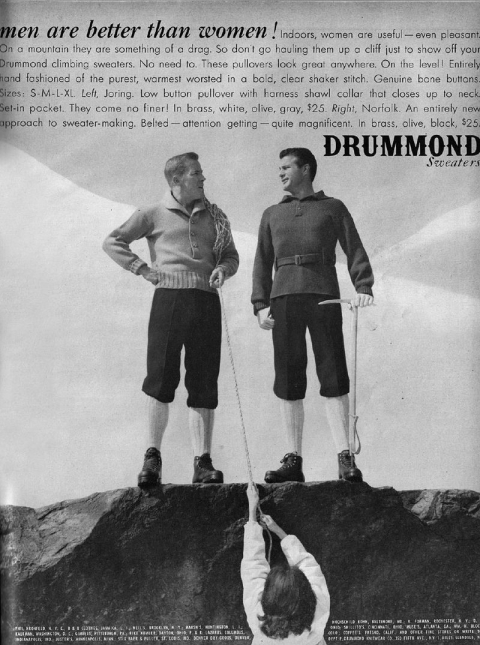-
Recent Posts
Recent Comments
- y8 happy wheels on 1950s Ads/commercials aimed at Women
- gorzow nieruchomosci on 19th century Household Technology
- When it comes to personal loans USA | 7N4ctwqy on Pros vs Cons of Gay Marriage
- idaho virtual office on Experience of Surrogacy
- Gansu, said construction lax control caused the day of a highspeed 31 kilo | www.louboutinpascher1221magasin.frkalF on Surrogacy in India
Frequent Topics
- 20th century
- 1950s
- Adolescents
- american dream
- anonymous
- birth
- census 2011
- childhood obesity
- children
- children under 2
- chores
- Christian fundamentalist
- commercial
- consumerism
- eugenics
- Family
- female targets
- Foucault
- gay
- Gay Marriage
- guest workers
- home economics
- homosexuality
- Homosexual Warning
- household roles
- Immigrants Hope Their 'American Dream' Isn't Fading
- kitchen
- majority not white
- marketing
- Media & Advertising
- minorities
- motherhood
- New York Times
- privacy
- Pros vs Cons of Gay Marriage
- school
- segmented marketing
- Slavery
- Social Media
- social network
- surrogacy
- television
- us population
- women
Archives
Categories
Meta
Category Archives: Assignment 2
History Of Consumerism In The United States
http://www.articlepros.com/History/American/article-79412.html
After carefully reading this article, I have found the article to be relevant to the problems we are facing today; for example, the author in his introduction compared present day consumerism to that of the pilgrims whose lives were based on simplicity and frugality. He sees consumerism as the main driving force in the United States today.
Another interesting fact noted in the article, is although some segments of the American society has had critical point of views of consumerism, it has prevailed throughout the years and has withstood the test of time.
The author in addition sees consumerism as a concept that is being used by many as means of expressing their emotion. He noted that some consumers’ happiness is based upon their ability to purchase tangible things which they can consume and enjoy. The study of the history of consumerism entails two approaches. Firstly, the rise of consumerism in the United States is seen from a general point of view of emphasizing some philosophical and ideological of consumerism in this modern society. Secondly, a brief history also examines a chronological point of view placing more emphasis on some relevant dates and consumer culture presently in the United States.
It is also noted in the article that consumerism has been growing steadily especially in the twentieth century and technological advances has enabled production to be increased. The author also credited American consumerism with the creation of public relationship.
The author in his view sees consumerism and globalization as two processes or forces that are interlinked and as such they are very important to our understanding of the role in which they play in the United States.
Posted in Assignment 2
Tagged History of Consumerism in The United States
Comments Off on History Of Consumerism In The United States
Will Fetal Science Lead to Lawsuits?
in an article in the New YorkTimes about an interview done about a book called “Origins: How the Nine Months before Birth Shape the Rest of Our Lives”, by Annie Murphy Paul explain the kind of research that is done about the fetuses and how much of this research is actual in the advantage of the baby and or the mother. This book mainly focuses on the potential uses and misuse of the research. Fetal origins research started 20 years ago and it’s the idea of conditions women experience during the nine month they are pregnant, all of this can affect our health and well=being for the rest of our lives. But this idea was denied by the scientists and medical field in the 20th century and they stared to give women all these drugs such as DES and thalidomide. They believed that the fetus was sealed away and nothing will be able to harm them, but unfortunately, all of that was wrong when the babies were born.
With this sort of research a lot can be done in protecting both the fetus and the mother. But according to Lisa Belkin “Would it be a trigger for greater resources toward helping pregnant women be healthy? To reduce their stress, improve their nutrition, and clean their environments? Or would it become just one more way to blame the mother?” or would it still remain the same?
Hazards of Child Consumerism
In a marketing class I was taking, I learned about the term “clutter”. According to Wikipedia.com clutter means,
“the large volume of advertising messages that the average consumer is exposed to on a daily basis. This phenomenon results from a marketplace that is overcrowded with products leading to huge competition for customers.”
Think about the enormous amounts of marketing and advertising campaigns that you are bombarded with on a daily basis, it’s truly mind boggling, everywhere you go there are product placements. After reading Lisa Jacobson’s article on child consumers, I realized what a large role they place in this as well. Although the articles study only goes until 1940, its concept still applies today more so then ever, with the internet, with television, and all the magazines and books that children look through. Children have a much harder time distinguishing between their wants and needs, so if we see ten advertisements we may want all of them, but realize that we only need / can afford a few of them, children on the other hand feel that they would need all ten products. In the article Lisa talks about class distinction, and how children in the lower classes cannot get everything they want, which can lead events that are discussed in this clip: Children Consumers. It also talks about the problems that products can create between parent and child, when the child does not receive everything they desire, and begins to question/disobey their parent’s authority. It’s a slippery rope, because you cannot hide them from all of the advertisements, if you buy them everything they seek, they will become spoiled and wont learn the value of a hard dollar. On the other hand if you don’t it might create problems in your relationship. How do you find a viable compromise?
The Horrifying American Roots of Nazi Eugenics
In class we discussed eugenics and the idea of a “perfect race”. This has taken shape in many minds and has been interpreted in many different ways. In this HNN article it becomes obvious what an important part history plays in this evolution of genocide. From the minds of American scientists to Adolf Hitler. It’s a little shocking to find out that Hitlers inspiration for his actions came from an American idea of what a perfect world should be made up of. It’s the creation of a domino effect.
I find it very interesting how one can even have the idea that there is a certain physical appearance or certain characteristics that can be deemed as superior and better than any other. How does one have the say of what or who is “the best”? It’s just a way people find to feel superior and undermine anyone else that might threaten that. The whole idea of eugenics just seems so stupid. As if any person who comes out of two successful people can’t turn out to be messed up and make mistakes. Every person has the ability to make mistakes, it’s what a human being does.
The fact that these American eugenicists decided to point fingers and say someone is not worthy of reproducing led to an ultimate idea of genocide and resulted in countless deaths. It should never be in the hands of one group of people to decide who’s worthy of having life and who isn’t.
Kitchens of the Future
I found on YouTube a 1956 GM promotional film “Design for dreaming” aimed for the upper-middle class as well as upper class. This film shows us how manufacturers were targeting and selling to only that specific target market. This promotional film is amazing, almost futuristic with specific goal to sell “dream life” to females that can afford it. I was surprised how technologically advanced the “dream kitchen” was in the film. The movie starts with a white female all dolled up singing around about how she wants to get a break like all men do as she enters this “dream kitchen” and she is about to bake cake. She begins to sing about how she has never seen a kitchen like this one and gets into the details by showing how easy is to press different buttons and everything gets done for you. After she finished putting ingredients in the different futuristic appliances she leaves the kitchen and sings “Tic Tock Tic Tock, free to have fun around the clock”. This shows us how manufacturers were focused onto not only selling appliances but the benefits that came with this kitchen such as: free time for leisure activities.
The lady leaves the kitchen and changes her clothes a few times in outfits for tennis, golf and swimming. The point is to show that, while her cake is baking she has time to do all these activities, after she comes back home her cake is magically ready. I found this film unrealistic even for our times, although maybe it is real in upper classes but I doubt that. In conclusion, this film proves that in 1950’s manufacturers were mainly concerned with female consumers that had enough disposable income, specifically white upper-middle class. I believe, this film is a perfect example of everything we have read in the class about the consumers of the postwar era and the target market before the influence of newly emerged “middle-class” that changed the way manufacturers segmented target audience.
Posted in Assignment 2
Tagged 1950s, consumerism, promotional film, television, upper-middle class, women
4 Comments
“Maafa 21 The History of Eugenics In America Part 2 of 13”
Maafa 21 The History of Eugenics In America Part 2 of 13
This video is about Eugenics in America. After slavery was abolished the White race panicked and feared that the Black population would out number them. They decided to limit the black population by controlling how many children they could have, creating birth control and steralizing many of them.
The film is part 2 of 13 and it goes it depth on how the system worked. American Eugenicists tried their hardest to get rid of the Black population. This is a shameful part of American history, the land of the “free.”
Beauty over Comfort
Choosing beauty over comfort is something I’m sure we’re all guilty of. As we discussed in class, many individuals of the upper class purchase couches that are expensive and yet pretty uncomfortable. We can discuss why people of high culture spend so much money on uncomfortable couches and the only answer we can ultimately come up with is because it’s pretty and they would rather have an uncomfortable couch that was expensive instead of a decent looking couch at reasonable decent price all because their furniture is not actually meant to be used but to show off and look at.
The same rules apply for women who try to look nice for their husbands and for everyone in general when they step out the door. Tim Gunn, American fashion consultant and cohost of Project Runway, explains this idea perfectly in his article. He begins with saying that yes and “oversized t-shirts feel soft on your body, but you know what’s genuinely comfortable? Being dressed appropriatekly for your surroundings.” As a society, the women back then were focused on choosing the white or yellow frige, now we’re all worrying about what to wear and where and impressing passerbys all day. The idea he uses to back up his argument is that ‘when we look, we feel good.’
He even mentioned how he read an articel abnout a woman who even after being married to her husband for years, she made it her responsibility to get ready and make herself beautiful before he came home. He prasied the idea, I for one thought it was a bit much.
Is this what not just women with their fridges or their husbands, but society as a whole is oming down to?!
Posted in Assignment 2
Comments Off on Beauty over Comfort
1950s Ads/commercials aimed at Women
In the 1950s women were the primary consumers; the ones who made decisions on what was needed at home. Therefore I was curious on how did the market researchers of the 1950s and 1960s market products to women. The first one is a commercial for a refrigerator from the 1950s made by the company Kelvinator Refrigerator. It reminded me of the “more is better” state of mind during this period. For everyone who sees it, please note the amount of food in that refrigerator (LOL). It made me wonder how many people lived in this home during this time.
Apart from finding the conventional cheerful ads from these times, I did encounter some that were not so jolly but quite sexist. Coming from a post-feminist perspective I thought they were quite hilarious. But I think it is interesting that albeit the sexist remarks projected by the ads, these women still bought the products marketed to them. Even if it continued to reaffirm the stereotypes of women during these decades. Most of the advertisement I came by during this period were either made for white women/wives/mothers and white families. But looking ahead in the late 1960s, I did see the transition into market segmentation. More ads were aimed at African Americans than before. What follows were ads marketing to women in the 1950s:






I particularly enjoy the last one because during these time researchers were also understanding that women were not the only ones they should market to; but men also.
Consumerism and Pop Culture
Pop culture is a very dynamic entity, it decides what’s cool, what’s lame and has the ability to tell people what to buy therefore can be the deciding factor in the financial decisions multi billionaires make. It’s also something that will inevitably change over and over again throughout time. I always wonder who is it really that controls pop culture, because it isn’t something tangible, we can’t hold it in our hands or ask it what the next cool thing is going to be. Pop culture is simply formed of ideas that are shared and filtered through word of mouth and whatever means of communication exist in that period of time whether it be the telephone, written mail, magazines, newspapers, e-mails, etc. Then those ideas get filtered again and picked up by the consumers, whichever idea becomes the most popular will have the most invested, time, interest, and money therefore becoming “cool.”
What was cool in the 50’s and 60’s may not be cool these days, marketing strategies were different, morals were different, ideals were different, and the climate of pop culture was different. It’s amazing to see that there were such blatantly bias/racist advertisements in the past decades of the United States until someone presented the idea that let’s get the most money out of EVERYONE possible no matter what race, or social class, let’s just make some money. I don’t mean to sound like an old man after all I’m only in my early 20’s but back when I was a kid the main consumer demographic was at the age of 18-30 years old. Nowadays it seems like with this new tween wave of consumerism the main demographic is ages 9-12, which is considerably smaller and since when did children have such influence over the financial industry anyway because let’s face it, what’s “cool” is what is going to be making money anyway. I don’t know where this came from and I’m not a big fan of it, but I don’t wish it gone from existence I just would like a reason to all this successful tween consumerism being thrown in my face every time I turn on the television. Again I’ll just chalk it up to the ever changing entity of pop culture and what was cool and okay to do back then is different now. I posted a YouTube video of an old Jell-O commercial that seems questionable if it were on the air today but again this is pop culture in the 1960’s for you guys. It can be considered a stereotypical and offensive commercial to people so I’m just putting that out there for anyone who clicks the YouTube video.
Take Care,
Ryhan Ahmad
Posted in Assignment 2
Tagged commercial, consumerism, cool, financial, pop culture, television, tween
3 Comments
A New Use for PGD by Molly Mallin
I have out from this class what PGD is and what it is used for. In this article, they present a unique reason for using it. In this news article: Embryo genetic screening controversial- and successful from USA Today, Molly Nash’s parents turned to using PGD (preimplantation genetic diagnosis) to pick out an embryo implanted to give birth to her brother Adam, in an attempt to save Molly’s life.
The procedure with PGD involved the cord blood cells of Adam which were transplanted into Molly. Adam was picked for this because his immune system characteristics made him the perfect transplant candidate for his sister.
This definitley can give rise to some controversy on the side of the professionals regarding PGD. In the USA Today article, it says that Leon Kass, a former bioethics council chief of the American Enterprise Institute, brought up the issue of these newborns feeling unloved because of undergoing this procedure.
Other professionals worried PGD would be used on a widespread level for sex selection procedures at fertility clinics. This was stated in the article about the 2002 President’s Council on Bioethics. They were concerned about this issue.
In my opinion, this is actually a terrific procedure, (PGD and the transplant) which I think the professionals are over-reacting to. Molly Nash’s parents are not using PGD to create a designer baby. Nor are they being selfish in this situation. Their daughter, Molly was dying and she prevailed because of this great procedure. This procedure didn’t harm Adam either.
In the article we read for class: Born and Made by Sarah Franklin and Celia Roberts it says, on page 10, “At one level PGD is a technique, but it is also a choice, an experience, a threshold, a clinical specialism, a scientific achievement, and as we shall see, a place from which a particular kind of uncertainty and ambivalence is generated alongside confidence in its refinement, expansion and success”. This is true in this case, especially, with the Nash’s because success was achieved with the use of PGD and the transplant. In this way using PGD for the right reasons is necessary and in my opinion the transplant was truly a miracle.
Posted in Assignment 2
Comments Off on A New Use for PGD by Molly Mallin


